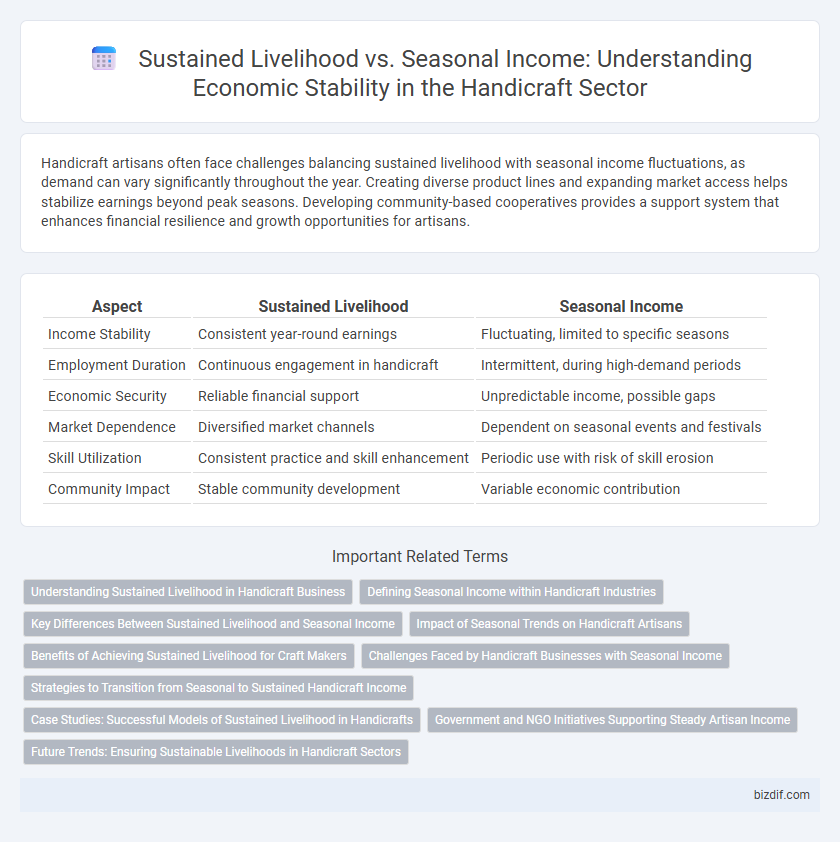Handicraft artisans often face challenges balancing sustained livelihood with seasonal income fluctuations, as demand can vary significantly throughout the year. Creating diverse product lines and expanding market access helps stabilize earnings beyond peak seasons. Developing community-based cooperatives provides a support system that enhances financial resilience and growth opportunities for artisans.
Table of Comparison
| Aspect | Sustained Livelihood | Seasonal Income |
|---|---|---|
| Income Stability | Consistent year-round earnings | Fluctuating, limited to specific seasons |
| Employment Duration | Continuous engagement in handicraft | Intermittent, during high-demand periods |
| Economic Security | Reliable financial support | Unpredictable income, possible gaps |
| Market Dependence | Diversified market channels | Dependent on seasonal events and festivals |
| Skill Utilization | Consistent practice and skill enhancement | Periodic use with risk of skill erosion |
| Community Impact | Stable community development | Variable economic contribution |
Understanding Sustained Livelihood in Handicraft Business
Understanding sustained livelihood in the handicraft business involves recognizing consistent income streams generated through diversified product lines and stable market demand. Artisans who develop unique, high-quality crafts and leverage e-commerce platforms tend to secure long-term financial stability. Building customer loyalty and establishing partnerships with fair-trade organizations also enhance sustained livelihood beyond seasonal income fluctuations.
Defining Seasonal Income within Handicraft Industries
Seasonal income in handicraft industries refers to the irregular earnings generated during peak demand periods, often aligned with festivals, holidays, or tourist seasons. This income pattern results from fluctuating market demands, causing artisans to experience income variability throughout the year. Understanding seasonal income is crucial for developing strategies that stabilize earnings and support artisans' sustained livelihood.
Key Differences Between Sustained Livelihood and Seasonal Income
Sustained livelihood in handicraft involves consistent income generation throughout the year, ensuring stability for artisans and their communities. Seasonal income, on the other hand, depends heavily on specific periods or festivals when demand for handicraft products peaks, causing fluctuations in earnings. Key differences include income regularity, economic security, and capacity for long-term financial planning, with sustained livelihood offering continuous economic benefits compared to the sporadic nature of seasonal income.
Impact of Seasonal Trends on Handicraft Artisans
Seasonal trends significantly impact handicraft artisans by causing fluctuations in income and work stability throughout the year. Limited demand during off-peak seasons leads to reduced earnings and challenges in maintaining a sustained livelihood, impairing artisans' financial security. Adopting diversified product lines and leveraging online marketplaces can help artisans mitigate the adverse effects of seasonal income variability.
Benefits of Achieving Sustained Livelihood for Craft Makers
Achieving sustained livelihood enables craft makers to secure consistent income, reducing vulnerability to market fluctuations inherent in seasonal sales. This financial stability fosters investment in skill development, quality improvement, and innovation, enhancing product value and market competitiveness. Sustained income also supports better access to resources and financial services, promoting long-term economic resilience and social well-being among artisans.
Challenges Faced by Handicraft Businesses with Seasonal Income
Handicraft businesses with seasonal income face challenges such as cash flow instability, limiting their ability to invest consistently in materials and skilled labor. This irregular revenue impacts sustained livelihood, making it difficult to manage operational costs and plan long-term growth. Fluctuations in demand during off-peak seasons often lead to income insecurity and increased vulnerability for artisans.
Strategies to Transition from Seasonal to Sustained Handicraft Income
Diversifying product range and targeting multiple market segments helps artisans maintain a steady cash flow beyond peak seasons. Implementing online sales platforms and leveraging social media marketing extend market reach and reduce dependency on local festivals or tourist seasons. Establishing cooperative networks provides access to shared resources, skill development, and consistent order pipelines, strengthening sustainable income generation in handicraft communities.
Case Studies: Successful Models of Sustained Livelihood in Handicrafts
Successful models of sustained livelihood in handicrafts demonstrate consistent income generation through diversified product lines, skill development, and market linkages. Case studies from regions like Rajasthan, India, and Oaxaca, Mexico reveal artisans leveraging e-commerce platforms and cooperative structures to stabilize earnings beyond seasonal peaks. Integrating traditional craftsmanship with contemporary designs ensures year-round demand, mitigating the risks of seasonal income fluctuations.
Government and NGO Initiatives Supporting Steady Artisan Income
Government and NGO initiatives emphasize skill development, market linkage, and product diversification to ensure sustained livelihoods for artisans beyond seasonal income fluctuations. Programs like the Handloom Sector Scheme and Deen Dayal Upadhyaya Gramin Kaushalya Yojana provide financial aid, training, and access to broader markets to stabilize artisan earnings year-round. Collaborative efforts also focus on creating e-commerce platforms and cooperative societies that enable artisans to consistently engage in handicraft production and sales.
Future Trends: Ensuring Sustainable Livelihoods in Handicraft Sectors
Handicraft sectors are increasingly adopting sustainable livelihood models by integrating eco-friendly materials and digital marketplaces to stabilize income throughout the year. Future trends emphasize skill diversification and value addition to reduce dependency on seasonal demand fluctuations. Empowering artisans with access to microfinance and technology enhances resilience and promotes continuous economic growth in the handicraft industry.
Sustained Livelihood vs Seasonal Income Infographic

 bizdif.com
bizdif.com